The Mesolithic Settlement of Lipno
The Mesolithic Period - characteristic of a transitional period of the Stone Age intermediate between the Paleolithic and the Neolithic periods (approximately 8300 - 5500 BC) - is typical for the hunting and collecting way of living. People did not use to build permanent settlements, but only short-period seasonal settlements. They fed themselves on hunting, picking up herbs, and lived in smaller movable groups, wandering after food or raw material at long distances. It is very rare to find more conspicuous signs unless the place was visited more often due to the abundance of food or raw material habitation.
Completely unknown Mesolithic localities in Dolní Vltavice Basin were discovered by Zdeněk Petr and his friends. They collected a large number of Mesolithic fissionable industry after the surface level of Lipno dam had fallen off in 1983 - 1985. Dr. Slavomil Vencl (Institute of Archaeology ČSAV in Prague) followed up with his own researches. He verified and completed the previous archaeological researches. They gained altogether 2,620 pieces of tools, their semi-finished articles and a large number of industrial waste coming from imported and local raw material from fifteen localities. Finding places are situated at 723 - 725 metres above sea - level. They prove the first Mesolithic settlement in the uplands area in Bohemia.
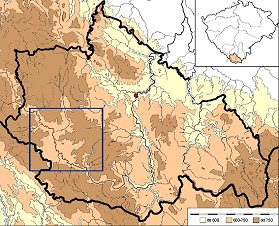
|
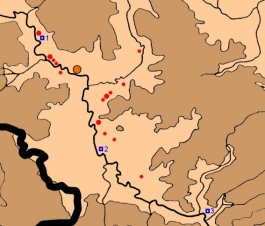
|
Only five or six localities out of fifteen can be confirmed as evidence regarding real settlements. The rest of discoveries shows intensive use of the local countryside by Mesolithic population. The locality of Hůrka (picture 2 - orange mark in the black circle) has become the most important Mesolithic locality in Lipno dam area so far. It is situated on the island-peninsula (736 metres above sea level), about 4 kilometres south-east of a small town of Horní Planá. A conspicuous headland at a confluence of the Vltava river and the Ostřice river had been used by people even later, as it was proved by the discovery of a cut fragment and some pottery dating from the early and late Stone Age. Altogether 2,256 pieces of Mesolithic fissionable industry (86 % fragments coming from all fifteen finding places) come from Hůrka. Plenty of production waste (approximately 65 %), semi-finished articles (approximately 22 %) and a number of cores (picture 5), tools made by knocking cores off (approximately 7,5 %) and other 120 tools, for example, scrapers (picture 3) and blades or spikes (picture 4) have been preserved in the collection. A wide range of raw material used to make different kinds of tools was found in the locality of Hůrka 4 . It is very various according to Dr. V. Novak´s discoveries. Imported speckled horn-stone from Franc Jury dominates (approximately 65%), and silica serpentines (approximately 11 %), opals and a great variety of quartz from local raw material (altogether 25 %).
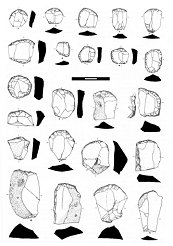
|
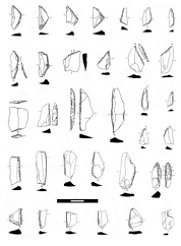
|
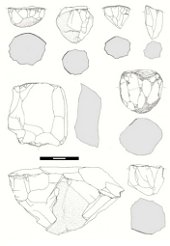
|
Discovery of the very intensive settlement in such altitude (approximately 700 - 800 metres above sea level) and a quite wide and flat basin of today´s Lipno dam seems to have a great significance from many reasons. Localities were discovered by some lucky chance (during the fall of surface level) only in the accessible north-east side of the dam (the other part was located in the borderland zone). The existence of many other finding-places in the area can be assumed. The density proves an easy access and intensive use of the local countryside. Mesolithic population could have lived there for a long time until the Neolithic Period. The Neolithic settlement is known from the town of Český Krumlov, only 20 kilometres faraway from Hůrka. (The Primeval and Early Middle Ages Settlement in the Area of the Town of Český Krumlov). A great variety of stone materials was used by local people in order to make tools. It also proves the good knowledge about the local environment. It was conditional on a long-term stay and trade intercourse at long-distances. Speckled horn-stone from Franc Jury dominates and indicates contacts towards the west. Silex occurs rarely. Horn-stone "Český Kras" from Central Bohemia or quartz "Skršín" from the Most area and north-west Bohemia was brought from Bohemia inland. All the mentioned factors support the knowledge about intensive use of the region and various trade intercourse at long-distances. The question regarding the Neolithic farming society has not been solved so far. They used lower located areas suitable for farming.
The publication by Dr. Slavomil Vencl (Vencl, S. 1989) is highly recommended to everyone interested in detailed information: "Mesolithic Settlement in the Bohemian Forest". Archaeological Reviews XLI, 481 -505. The article describes individual discovered localities, descriptions of discovered things and plenty of pictures.
(me)
Further information:
The
Archaeological Researches in the Český Krumlov Region
The
Primeval Settlement in the Český Krumlov Region
The
Celtic Settlement of Třísov

